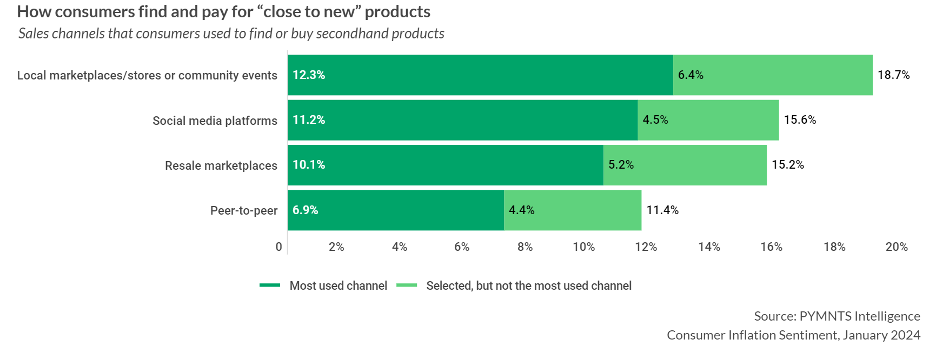Consumers Turn to Social Media Platforms for Secondhand Products as Resale Partnerships Surge

As the economy continues to grapple with rising prices and inflationary pressures, consumers are adjusting their purchasing habits to cope with the erosion of their purchasing power.
In fact, a mere 18% of wage earners believe their incomes have matched inflation, prompting a shift toward conservative spending habits. In response, consumers are cutting back on nonessential purchases and opting for more budget-friendly retailers. This has driven a notable uptick in the popularity of secondhand alternatives as a cost-effective solution.
According to findings detailed in “Persistent Inflation Rekindles Consumer’s Interest in Secondhand Markets,” the latest installment in the “Consumer Inflation Sentiment” series by PYMNTS Intelligence, more than 40% of consumers purchased a secondhand product in 2023.
This includes nearly half of high-income consumers, suggesting that even affluent consumers are recognizing the economic advantages of buying secondhand. While these high earners are less likely to use secondhand channels for clothing, they are more inclined to utilize them for furnishings and electronics.
The report reveals that consumers report saving up to 35% by shopping at secondhand retailers compared to buying new products, further contributing to the growing popularity of the secondhand market — particularly during challenging economic periods.
“Resale is starting to blossom globally, with many of the largest retailers in the world adopting more circular business models,” James Reinhart, CEO at online consignment and thrift store ThredUp, said last year, per PYMNTS, adding that “value continues to be a key driver that motivates consumers to think secondhand first […].”

When it comes to how consumers find and pay for “close to new” products, local marketplaces and community events emerge as the top choice, attracting nearly 20% of consumers. Following closely are social media platforms and resale marketplaces, each favored by around 15% of consumers. Meanwhile, peer-to-peer transactions rank as the least utilized channel, although more than 10% of consumers still rely on this option to procure secondhand products, according to the study.
Overall, the secondhand market is projected to surge from $177 billion in 2022 to $351 billion in 2027. Notably, the U.S. secondhand apparel market is set to double, increasing from $39 billion to $70 billion within the same timeframe.
In response to this trend, retailers and manufacturers are adjusting their strategies. Some are exploring the integration of secondhand offerings into their business models, while others are forming partnerships with established resale platforms to capitalize on this expanding market.
Luxury consignment platform Rebag, for instance, has broadened its consignment focus beyond the luxury sphere by entering into a new partnership with thredUP.
In a November interview with PYMNTS, Rebag founder and CEO Charles Gorra delved into the motivations behind the company’s expansion beyond luxury, particularly in challenging economic circumstances.
“The collaboration among players has already been in progress for a few years,” Gorra said. “Additionally, brand collaborations have been prevalent for quite some time. I just think we’re going to witness a significant increase in such collaborations.”
In conclusion, the report suggests that the secondhand market is no longer viewed as a compromise, but rather as a strategic and sustainable choice. As the trend continues, businesses across industries will need to adapt to meet the evolving demands of consumers prioritizing economic savings.